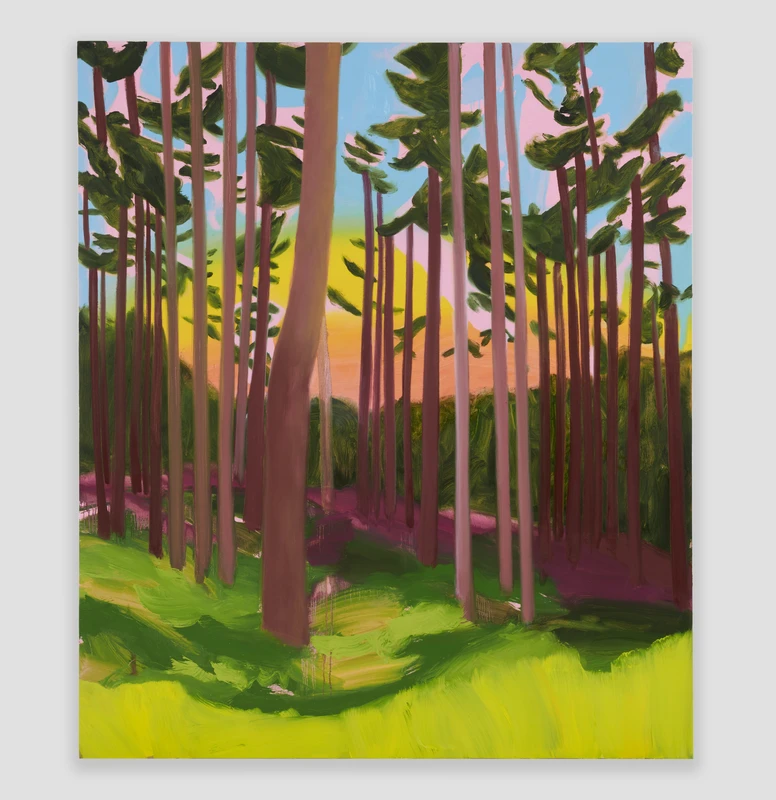Nicole Wittenberg: Moonshine Lullaby
12 Jan-4 Feb 2023


MASSIMODECARLO is pleased to announce Moonshine Lullaby, Nicole Wittenberg’s first personal exhibition with the gallery, showcasing a new series of glowing windswept natural landscapes.
Behind the hill
There's a busy little still
Where your Pappy's workin' in the moonlight
Your lovin' paw
Isn't quite within the law
So he's hidin' there behind the hill
Bye bye baby
Stop your yawnin'
Don't cry baby
Day will be dawning
And when it does
From the mountain where he wuz
He'll be coming with jug of moonshine
So count your sheep
Mama's singing you to sleep
With the Moonshine Lullaby
- Irving Berlin
Known for her previous erotic and body-focused works, Nicole Wittenberg turned to landscape painting to break free. Advised by teachers to paint what she saw and who she was, her earlier series depicted intimate sensual scenes. Bodies and bedrooms led her to paint feelings rather than herself. “You have been told how to think and how to feel, and what art is and what art isn’t, and then you ask yourself why it needs to be that way?”. For Wittenberg, landscape painting is a schism, a rapture that guided her to her true self.
The artist’s endless forests and luminous bending trees invite viewers to come closer. The quick, intuitive brushstrokes absorb us into a natural world made of acidic and surreal colours. The New York-based artist relies on her eyes; what she sees, although chromatically contrasting with reality, is portrayed truthfully and at the same time imaginatively. Wittenberg is chasing a perception of nature, prolonging a sensation rather than a vision. Bright colours burst from tree leaves, fiery pinks and tangy greens take over, bringing out an extravagant and unruly natural yet emotional landscape.
Inspired by the duality of Jewish-American identity that has inhabited America for centuries, Wittenberg, for this series, was particularly drawn by the character of Irving Berlin, an iconic Russian American music composer from the 20th century. Berlin, a Jewish immigrant who arrived in the US at age five, wrote some of the most famous American songs – one of which is Moonshine Lullaby. While fascinated by the history of Jewish immigrants and how they defined an exported style in the American creative industry, Wittenberg isn’t interested in exploring this cultural duality but rather in highlighting “how things appear, and how things are presented, isn’t really how they arrive or how they are created”. Berlin’s songs and
Wittenberg’s works share this antithesis and veiled truth.
While intrigued by the composer’s soothing lullaby and the familiar imagery it evokes, Wittenberg’s work is also informed by the Impressionist movement, where unusual angles and feelings transformed ordinary sceneries and objects into psychologically charged ones. The American artist, who follows this vein, particularly nods to Degas’ unconventional compositions and portrayal of movement. Wittenberg depicts landscapes through an odd, restricted angle; the tree crowns are cropped, and the trunks inhabit the canvases' foreground, becoming only apparent subjects of the works. The protagonist in Wittenberg's series, in fact, is not the bucolic, evergreen landscape but rather the emotions and sensations that nature awakens.
“I interpret the image into a feeling,” says the artist. Wittenberg roamed these forests, observed their lights, movements, and colours, listened to their sounds and rustles, absorbed their energy and brought it onto the canvas.
Moonshine Lullaby is a visual record of emotions and experiences that celebrates the unlandscaped nature of Maine. Wittenberg found inspiration in the vast forests, pristine wetlands, and rugged mountains characterising this Northeastern region. Untamed and emotional, Maine’s natural beauty is grasped by Wittenberg through quick – 20 minutes max – pastel studies. The artist, painting en plein air, as the Impressionists would do, captures fleeting moments while portraying humanity's ancestral fascination with nature.
Translating feelings into paintings, Wittenberg's work, with its enveloping tones and vivid colours, exudes a sense of reassuring familiarity. The artist's nature accompanies us into a dreamlike reality, lulling us into the sunset light.
---
Nicole Wittenberg was born in 1979, and she is an American artist based in New York City. She is a curator, professor, writer, and painter.
Wittenberg portrays natural landscapes that mirror her emotional state and feelings in a precise moment. Nodding to the Impressionist movement, the American artist transforms ordinary sceneries into psychological and emotional lands, manifesting a deep fascination for nature and its fleeting changes.
Wittenberg was born in San Francisco, CA, and received her BFA from the San Francisco Art Institute in 2003. She received the American Academy of Arts and Letters coveted John Koch Award for Best Young Figurative Painter in 2012. From 2011–2014 she served as a teacher at the New York Studio School of Drawing, Painting and Sculpture, and the Bruce High Quality Foundation University, and in 2017 she was a professor in the Critical Theory Department at the School of Visual Arts in New York City.
Wittenberg’s works are included in many prominent collections, including the Solomon R. Guggenheim Museum, New York, NY; The Albertina, Vienna, Austria; the Boston Museum of Fine Art, Boston, MA; Aishti Foundation, Beirut, Lebanon; and others. Exhibitions include The Female Gaze, Part Two: Women Look at Men at Cheim & Read Gallery, New York, NY; Painter's Painters: Gifts from Alex Katz, High Museum of Art Atlanta, GA; and In Her Hands, Skarstedt Gallery, New York, NY